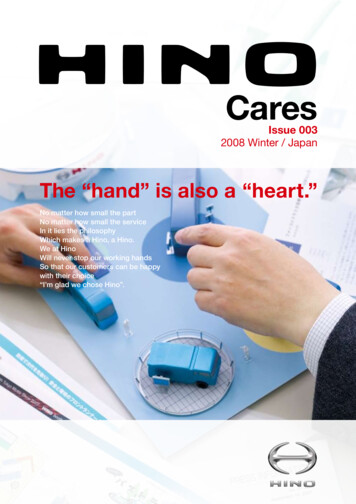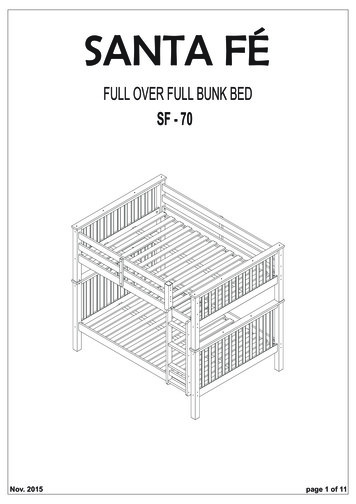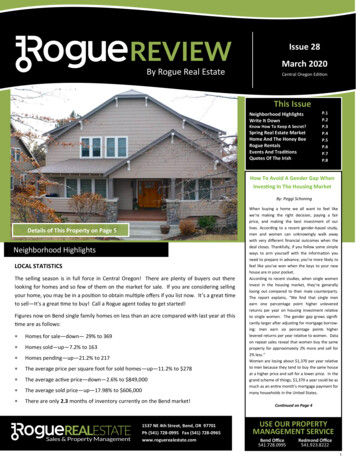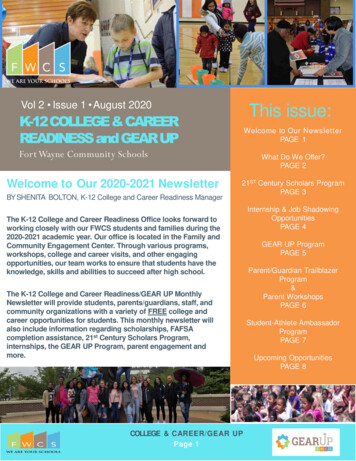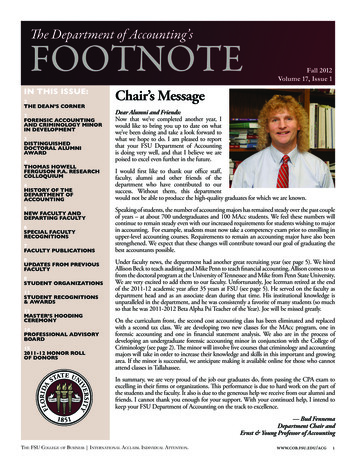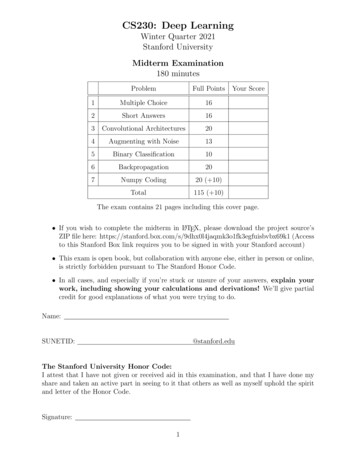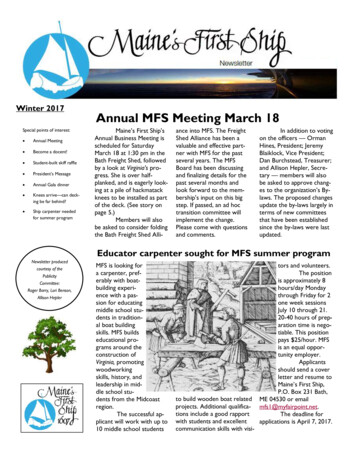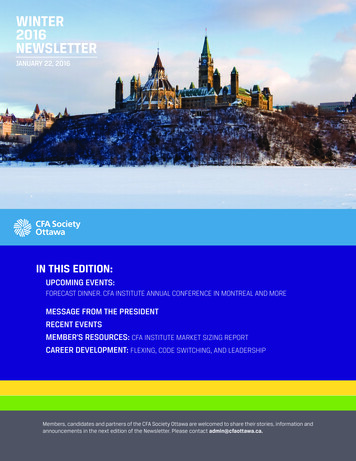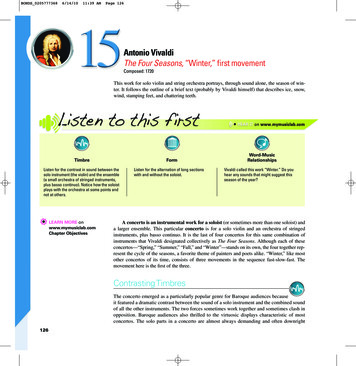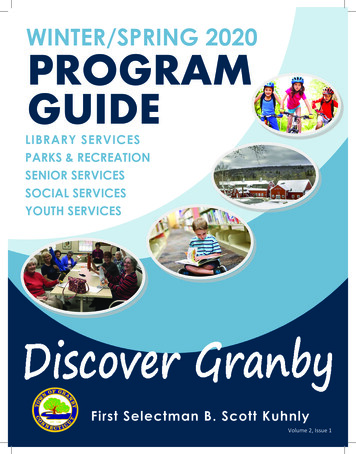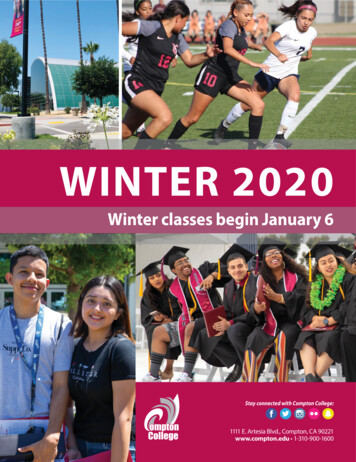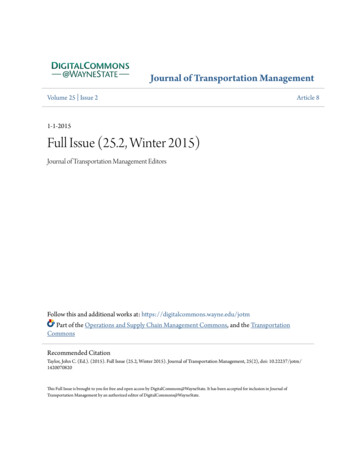
Transcription
Journal of Transportation ManagementVolume 25 Issue 2Article 81-1-2015Full Issue (25.2, Winter 2015)Journal of Transportation Management EditorsFollow this and additional works at: https://digitalcommons.wayne.edu/jotmPart of the Operations and Supply Chain Management Commons, and the TransportationCommonsRecommended CitationTaylor, John C. (Ed.). (2015). Full Issue (25.2, Winter 2015). Journal of Transportation Management, 25(2), doi: 10.22237/jotm/1420070820This Full Issue is brought to you for free and open access by DigitalCommons@WayneState. It has been accepted for inclusion in Journal ofTransportation Management by an authorized editor of DigitalCommons@WayneState.
Vol. 25 No. 2Winter 20157 A New Approach to Speaker Relevance Using a LLogisticsogisticsApproachRelevanceExecutive in Residence CourseResidenceStephen M. Rutner, Scott R. Cox and Maria E. Aviles25 Standardization of Highway Construction Delay Claim Analysis – AStandardizationHighway Bridge Case StudyMohammed S. Hashem Mehany and Neil Grigg43 Impact Of Fraffic On School Walking DecisionsFrreight TTrafficWalkingIn Urban EnvironmentsEnvironmentsStephanie S. Ivey, Marian Levy, Marla B. Royne, Kelsey Fordand Kranthi Guthikonda57 MMOG/LE: Improving Supply Chain Delivery Performance Through BuyerImprovingPerformanceThroughBuyer-Supplier CollaborationTimothy W. Butler, David L. Williams and Tingting YanWinter 2015
Journal of Transportation Management
EditorDr. John C. TaylorWayne State UniversityAssociate EditorsDr. George C. JacksonWayne State UniversityMichael A. McGinnisThe Pennsylvania State UniversityNew KensingtonDelta Nu Alpha Support ServicesLaura PlizkaDelta Nu Alpha Transportation FraternityWinter 2015
Editorial Review BoardReviewBoardFrederick J. BeierUniversity of MinnesotaGeorge C. JacksonWayne State UniversityRobert L. CookCentral Michigan UniversityCarol J. JohnsonUniversity of DenverMartha CooperOhio State UniversityScott B. KellerUniversity of West FloridaMichael R. CrumIowa State UniversityJohn L. KentMissouri State UniversityWilliam A. CunninghamAir Force Institute of TechnologyLeonard J. KistnerFort Valley State UniversityJames M. DaleyRockhurst UniversityDaniel F. LynchDalhousie UniversityPatricia J. DaughertyUniversity of OklahomaKarl ManrodtGeorgia Southern UniversityKathryn DobieNorth Carolina A&T State UniversityRay A. MundyUniversity of Missouri at St. LouisM. Theodore Farris IIUniversity of North TexasMichael A. McGinnisThe Pennsylvania State UniversityNew KensingtonBrian J. GibsonAuburn UniversityThomas J. GoldsbyUniversity of KentuckyStanley E. GriffisMichigan State UniversityCurtis M. GrimmUniversity of MarylandJon S. HelmickU.S. Merchant Marine AcademyJournal of Transportation ManagementJohn OzmentUniversity of ArkansasTerrance L. PohlenUniversity of North TexasAnthony S. RoathUniversity of OklahomaEvelyn A. ThomchickPennsylvania State UniversityTheodore O. WallinSyracuse University
Delta Nu Alpha International BoardBoardJim Hall - PresidentHenry Seaton - 1st Vice PresidentSue Spero - 2nd Vice PresidentDon Adams - Secretary / TreasurerLaura Plizka - Assistant Secretary / TreasurerDirectorsChristopher Burns - DirectorMelinda Burns - DirectorMarvin Claywell - DirectorGary Heinz - DirectorSally Lubinski - DirectorYai Malave - DirectorJeff Wilmarth - DirectorContact InformationDelta Nu Alpha Administrator1720 Manistique AvenueSouth Milwaukee, WI ta Nu Alpha Membership InformationSee back page for form.ISSN# 1058-6199Winter 2015
Global SupplyChain ManagementJournal of Transportation Management
Editorial PolicyThe primary purpose of the JTM is to publish managerial and policy articles that are relevant toacademics, policymakers, and practitioners in the transportation, logistics and supply chain fields.Acceptable articles could include conceptual, theoretical, legal, case, and applied research thatcontributes to better understanding and management of transportation and logistics. Saying that, ourpolicy requires that articles be of interest to both academics and practitioners, and that theyspecifically address the managerial or policy implications of the subject matter. Articles that arestrictly theoretical in nature, with no direct application to transportation and logistics activities, or torelated policy matters, would be inappropriate for the JTM. Articles related to any and all types oforganizations, and of local to global scope, will be considered for publication.Acceptable topics for submission include, but are not limited to, broad logistics topics, logistics andtransportation related legal issues, carrier management, shipper management of transportationfunctions, modal and intermodal transportation, international transportation issues, transportationsafety, marketing of transportation services, transportation operations, domestic and internationaltransportation policy, transportation economics, customer service, and the changing technology oftransportation. Articles from related areas, such as third party logistics, purchasing and materialsmanagement, and supply chain management, are acceptable as long as they are related totransportation and logistics activities.Submissions from practitioners, attorneys or policymakers, co-authoring with academicians, areparticularly encouraged in order to increase the interaction between groups. Authors considering thesubmission of an article to the JTM are encouraged to contact the editor for help in determiningrelevance of the topic and material.The Editor information is: Dr. John C. Taylor, Associate Professor of Supply Chain Management,Department of Marketing and Supply Chain Management, School of Business, Wayne StateUniversity, Detroit, MI 48202. Office Phone: 313 577-4525. Cell Phone: 517 719-075. Fax: 313577-5486. Email: taylorjohn@wayne.eduPublishing DataManuscripts. Submit manuscripts to the editor by email attachment at taylorjohn@wayne.edu.Manuscripts should be no longer than 30 double-spaced pages and 7000 words. Guidelines formanuscript submission and publication can be found in the back of this issue.Subscriptions. The Journal of Transportation Management is published twice yearly. The currentannual subscription rate is 50 domestic and 65 international in U.S. currency. Payments are to besent to Laura Plizka, Delta Nu Alpha, 1720 Manistique Avenue, South Milwaukee WI 53172.Revised March 15, 2013Winter 2015
From the Editor Welcome to the Winter, 2015 issue of the Journal of Transportation Management! This issue, beingVol. 25, No. 2 completes the 25th Anniversary of the Journal. This Silvery Anniversary is majormilestone in the history of the Journal and a tribute to the previous Editors and Authors of theJournal. We look forward to another even better 25 years.This issue of the Journal contains an article on a logistics executive in residence course, an article onhighway construction delays claim analysis, an article on the impact of freight traffic on schoolwalking decisions in urban environments, and an article on the auto industry’s MMOG/LE selfassessment processes for improving supply chain delivery performance.The first article is an excellent overview of the issues involved in starting a Logistics Executive inResidence course. Both the anecdotal and statistical evidence suggests that the Executive inResidence course increases interaction and improves learning with majors. The second articlediscusses highway construction efficiency, a topic which is critical to highway users such as thetrucking industry given today’s era of shortages in funding, and given the need for major reinvestments in the highway system. The analysis shows clearly that a standardized process for delayclaim analysis would improve highway construction contracting. The third manuscript presentsfindings from a study of urban neighborhoods in a major southeastern city, including those that areadjacent to freight corridors. The paper examines the impact of actual and perceived freight activityon school pedestrian safety. The fourth article introduces readers to a relatively new self-assessmenttool for measuring the readiness and effectiveness of supplier materials management and logisticsprocesses in the automotive industry. The authors address the various strengths and weaknesses ofthe MMOG/LE model, and make several recommendations on how the system and processes formanaging it could be improved.At the Journal, we are continuing to make a number of changes that will improve the visibility ofJTM, and improve its position in the supply chain publishing world. These include registering andupdating journal information with several publishing guides, placing the journal content with theEBSCO, Gale and JSTOR databases faculty have access to, and placing abstracts of all past journalarticles on an open area of the DNA Journal webpage. www.deltanualpha.orgI look forward to hearing from you our readers with questions, comments and article submissions.The submission guidelines are included at the end of this issue’s articles and I encourage bothacademics and practitioners to consider submitting an article to the Journal. Also included in thisissue is a subscription form and I hope you will subscribe personally, and/or encourage your librariesto subscribe.John C. Taylor, Ph.D.Editor, Journal of Transportation ManagementChairman, Department of Marketing andSupply Chain ManagementSchool of Business AdministrationWayne State UniversityJournal of Transportation Management
A NEW APPROACH TO SPEAKER RELEVENCE USING A LOGISTICSEXECUTIVE IN RESIDENCE COURSEStephen M. RutnerGeorgia Southern UniversityScott R. CoxAthens State UniversityandMaria E. AvilesGeorgia Southern UniversityABSTRACTThis article addresses a new method to bring real world relevance into the Logistics, Transportationand Supply Chain Management classroom. A different type of Executive in Residence coursefocuses on using multiple industry speakers to provide a unique learning environment for today’sMillennial majors. While the majority of the paper is a thought based overview, a statistical analysisof student responses was used to compare various types of relevant courses. A simple comparison ofvarious appropriate items was examined to identify if the Executive in Residence course increasedlearning. Both the anecdotal and statistical evidence suggests that the Executive in Residence courseincreases interaction and improves learning with majors. It highlights a non-traditional type ofapproach to incorporating executives into the curriculum and results in a more robust learningenvironment. The inclusion of active executives also creates a number of practical benefits for thepractitioners, students, faculty and university.INTRODUCTIONUnderstanding the absorption of knowledge is acomplex exercise and the different approaches inwhich people learn vary as widely as anyindividual human characteristic. Theseprocesses have been studied for many years bypeople intent on explaining, predicting andmanipulating the ways in which people learn(Potter and Maccaro, 2000). One of the mostimportant objectives of an institution of higherlearning is the ability to effectively conveyknowledge to the largest group of studentspossible. Students experience a variety ofapproaches employed by instructors designed tobalance theoretical learning and practicalapplication. In business education, the challengeof providing opportunities for undergraduatestudents to learn how to apply the concepts oftheir discipline has been discussed in theliterature for more than forty years (Achenreinerand Hein, 2010).One of the key drivers of this research is thatbusiness education has been admonished bypractitioners for not training students with thespecific knowledge and skills necessary tobecome practicing business professionals (Beebyand Jones, 1997; Cannon and Sheth, 1994;Byrne, 1992). There are a number of factors thatmake bridging the gap between theory andpractice a challenge for business schools. Oneof the most glaring is the lack of businessexperience by an increasing number ofacademics (Conant et al., 1988). However astudy conducted by Conant et al. (1988) notesthat students had a higher regard for teachersthat possessed real world perspective.One approach to bridging the gap betweentheory and practice is to bring businessprofessionals into the classroom. This brings abroader perspective and understanding of currentrelevant business practices to the students. Onemethod is to hire recently retired practitionersWinter 20157
into an Executive in Residence (EiR) position.The EiR then complements the traditionaluniversity faculty. An EiR course allowsbusiness practitioners to meet with students andprovide undergraduates with examples of “realworld” practitioner experiences in a universitysetting (Johnston, 2004). However, this is onlyone method to bring EiR onto campus to interactwith students.learning (Skinner, 1953). Second, a cognitiveview looks beyond behavior to explain brainbased learning (Mandler, 2002). Finally, there isa constructivist view where the learner activelyconstructs or builds new ideas or concepts(Driver et al., 1994). Behaviorism dominatedthe educational landscape twenty-five years ago,while the foremost learning theory today isconstructivism (Boghossian, 2006).This article will examine a different type ofLogistics and Transportation EiR course andattempt to evaluate the effectiveness of thisunique approach. The overall goal is to presentacademics and executives a new model toimprove the overall education of Logistics,Transportation and/or Supply ChainManagement students. After this introduction,there is a review of the appropriate literature anda discussion of the methodology to evaluate thecourse effectiveness. Also, there is a discussionof the perceived strengths and weaknesses of thenew EiR type class. Furthermore, there is anoverview of the course mechanics to allow otheracademics
Scott B. Keller University of West Florida John L. Kent Missouri State University Leonard J. Kistner Fort Valley State University Daniel F. Lynch Dalhousie University Karl Manrodt Georgia Southern University Ray A. Mundy University of Missouri at St. Louis Michael A. McGinnis The Pennsylvania State University New Kensington John Ozment University of Arkansas Terrance L. Pohlen University of .
